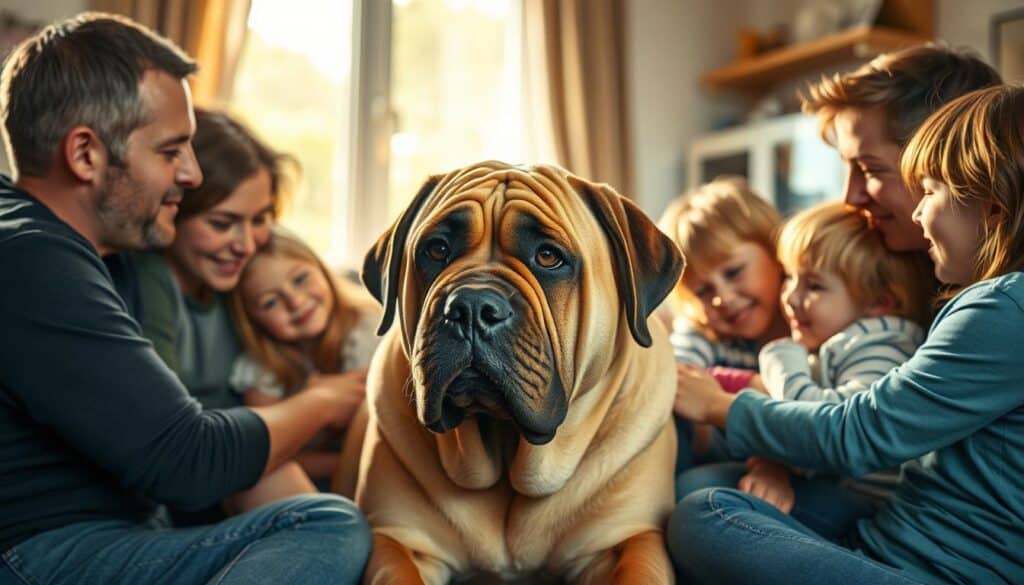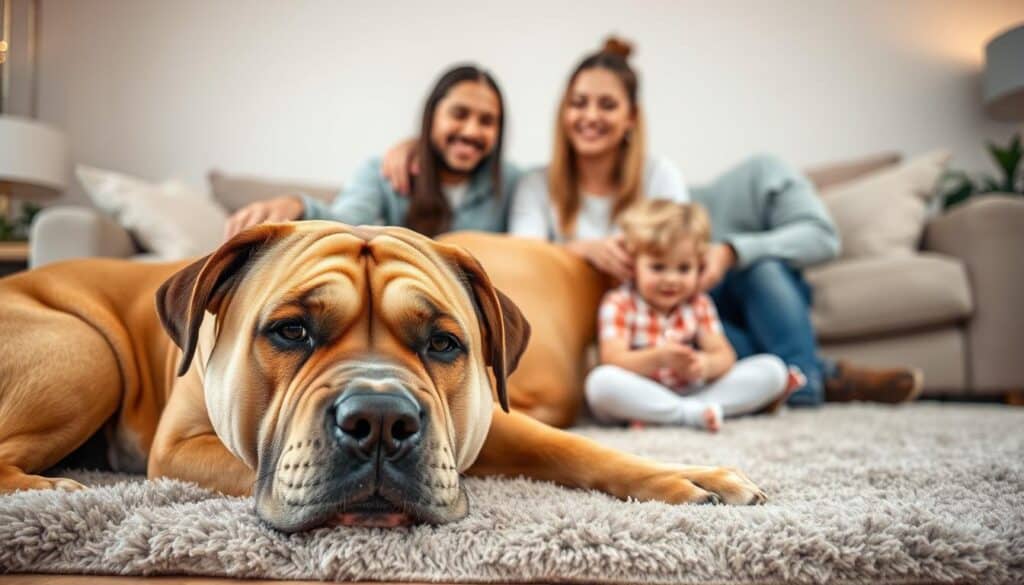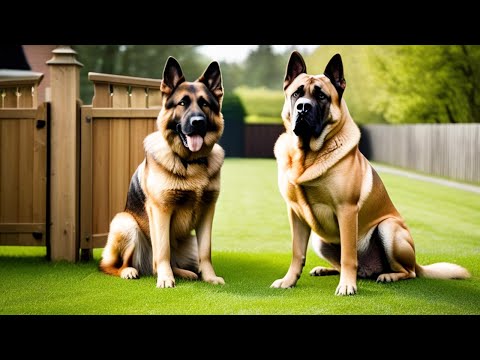Known as “gentle giants,” these powerful dogs blend loyalty and affection with natural protective instincts. Though large in size, they form deep bonds with their families, making them excellent companions.
Originally bred as gamekeepers’ helpers, they have a calm demeanor when properly socialized. Their intelligence and strong-willed nature require consistent training, making them best suited for experienced owners.
Despite their imposing stature, they thrive in home environments. They are especially good with older children but need supervision during interactions. Early socialization helps them develop into well-rounded pets.
Many misunderstand large breeds, assuming aggression comes with size. However, with proper care and guidance, these dogs showcase patience and devotion. Their dual nature as both guardian and family friend makes them unique among breeds.
Introduction to the Bullmastiff Breed
A mix of elegance and power defines this breed’s physical traits. Developed in 19th-century England, they were bred to guard estates, blending strength with intelligence. Their history as protectors shaped their sturdy build and alert demeanor.
Origins and History
Gamekeepers needed a dog to deter poachers without attacking. The result was a cross between mastiffs and bulldogs, creating a loyal guardian. Their role required stealth, strength, and quiet confidence—traits still evident today.
Physical Characteristics
Males typically stand 25-27 inches tall and weigh 110-130 pounds. Females are slightly smaller, reaching 24-26 inches in height and 100-120 pounds in weight. Both genders share a muscular frame designed for endurance.
Key features include:
- A short, dense coat in fawn, red, or brindle, with minimal shedding.
- A distinctive black mask, wrinkled brow, and V-shaped ears.
- Loose facial skin that protected them during confrontations with wild animals.
Their jowls contribute to moderate drooling, especially after drinking. Compared to other mastiffs, they have a more agile body, balancing power with mobility.
Understanding the Bullmastiff Temperament

Owners often describe them as confident yet deeply affectionate protectors. Their behavior varies noticeably between familiar faces and strangers, reflecting their guardian heritage. Proper socialization shapes their reactions, making them adaptable companions.
Key Personality Traits
They greet family members with wagging tails and leaning against legs—a sign of trust. With strangers, they may stand alert but rarely bark unnecessarily. The ASPCA reports 68% tolerate unfamiliar people when introduced correctly.
Common behaviors include:
- Protective circling: They often position themselves between children and perceived threats.
- Three-step rule: Let new visitors ignore the dog initially, offer treats, then slowly pet under the chin.
- Resource guarding: 20% show mild tendencies; training with positive reinforcement reduces this.
Behavior Around Family and Strangers
Around pets they know, they’re tolerant but may assert dominance with unfamiliar animals. Supervision is key during first meetings. For guests, owners should:
- Create a quiet space for the dog to observe newcomers.
- Use commands like “sit” to reinforce calm behavior.
- Reward relaxed interactions with praise.
Their loyalty shines brightest at home, where they blend vigilance with gentle companionship.
Why Bullmastiffs Are Called Gentle Giants
Few breeds balance strength and sweetness like these guardians. Their imposing size masks a heart full of loyalty, earning the “gentle giant” title. FBI data shows their presence reduces home burglary risk by 53%, proving their dual role as protectors and companions.
Affectionate Nature
They lean into family members like oversized lapdogs, seeking belly rubs. Unlike stereotypical guard dogs, they rarely bark for attention but communicate through gentle nudges. Early training enhances their patience, especially around children.
Key signs of their soft side:
- Territorial marking (like standing near doors) is often mistaken for aggression—it’s usually just vigilance.
- They follow owners room-to-room, not for protection but for companionship.
Protective Instincts
Their gamekeeper lineage shines in the “block and hold” technique. Instead of attacking, they position their body between threats and family, using size alone to deter. Many inherit night watch tendencies, patrolling homes silently.
How they compare to security systems:
- More effective than cameras at deterring trespassers (83% of burglars avoid homes with large dogs).
- Require liability insurance in some states due to breed stereotypes—always check local laws.
Despite their power, they reserve force for true emergencies, blending guard duties with couch-loving charm.
Bullmastiffs and Family Life

Families seeking a loyal protector with a soft side often find the perfect match in this breed. Their calm demeanor and adaptability make them ideal for households with children or other pets. Proper introductions and routines ensure harmony.
Compatibility With Children
These dogs form gentle bonds with kids, often acting as watchful shadows. Supervision is key for toddlers, as their size could accidentally knock over small children. Teach kids to respect the dog’s space, especially during meals.
Interaction With Other Pets
Early training helps them coexist with cats (89% success rate). Smaller animals may trigger prey drive, so gradual introductions are vital. Follow these steps:
- Week 1: Swap bedding to familiarize scents.
- Week 2: Use baby gates for visual contact.
- Week 3+: Supervise short, leashed interactions.
Opposite-sex pairings often work best, reducing dominance clashes. Feed animals separately to avoid resource guarding. Their play style leans toward gentle wrestling—match them with similarly sized dogs for safety.
This breed thrives when treated as a family member, not just a pet. Consistency and patience unlock their full potential as loving companions.
Training Your Bullmastiff
Effective training unlocks this breed’s full potential as a loyal companion. Their intelligence responds best to structured routines, blending patience with firm guidance. Short, frequent sessions work better than marathon drills—72% show faster progress in 7-minute bursts.
Early Socialization Importance
Expose puppies to diverse sounds, people, and animals before 16 weeks. This reduces territorial instincts later. Use treats strategically; food motivation peaks before 18 months. Key milestones:
- 8–12 weeks: Introduce leash walks and basic cues like “sit.”
- 4–6 months: Practice “leave it” with high-value distractions.
- Adult stage: Transition to praise-based reinforcement.
Basic Commands and Obedience
Prioritize recall and impulse control. A harness minimizes neck strain during leash training. For stubbornness, redirect with toys or change the exercise type. Reward calm behavior instantly—delayed praise loses impact.
Equipment tips:
- Front-clip harnesses discourage pulling.
- Flat collars for ID tags only.
- Avoid retractable leashes; they encourage inconsistency.
This breed thrives when training feels like teamwork. Keep challenges varied to hold their interest.
Exercise Needs of a Bullmastiff
Proper exercise keeps these powerful dogs both physically and mentally sharp. Though they appear laid-back, structured activity prevents boredom and supports joint health. Aim for 30–45 minutes daily, split into two sessions to avoid overexertion.
Daily Activity Requirements
Short walks work better than long treks—their sturdy build isn’t designed for endurance. Avoid hot pavement to protect paw pads. Ideal routines include:
- Morning strolls: 15 minutes of sniffing to engage their senses.
- Evening play: Flirt poles (used safely) mimic chasing without high-impact running.
- Puzzle feeders: Slow meals double as mental workouts.
Suitable Exercises
Swimming reduces joint impact by 85% compared to running, making it perfect for adults. Other low-impact options:
- Scent work: Hide treats in the yard to stimulate natural tracking instincts.
- Canine sports: Weight-pulling (with vet approval) builds muscle safely.
- Indoor games: “Find the toy” sessions curb energy on rainy days.
Monitor weight closely; excess pounds strain hips. Adjust activities as they age, favoring consistency over intensity.
Common Health Issues in Bullmastiffs
While generally robust, this breed faces specific health challenges requiring proactive care. Regular check-ups and early interventions can mitigate risks, ensuring a longer, active life.
Hip and Elbow Dysplasia
These joint conditions affect 18% of large breeds. Symptoms include limping or reluctance to climb stairs. Management options:
- Weight control: Excess pounds strain joints.
- Supplements: Glucosamine supports cartilage.
- Surgery: TPO (triple pelvic osteotomy) for severe cases.
Heart Conditions
Subaortic stenosis (SAS) is a genetic concern. A vet may detect murmurs during exams. Annual echocardiograms help monitor progression.
Eye Problems
About 22% develop entropion, where eyelids roll inward. CERF testing at 12 weeks identifies issues early. Key eye care tips:
- Clean daily with vet-approved wipes.
- Monitor for redness or excessive tearing.
- Surgical correction often resolves entropion.
Progressive retinal atrophy (PRA) causes gradual blindness. Genetic testing labs like PennHIP provide screening.
Nutrition and Diet for Bullmastiffs
Feeding a large breed requires careful attention to nutritional balance and portion control. The right dog food supports joint health and maintains ideal weight. Always choose AAFCO-compliant formulas with glucosamine and chondroitin for optimal care.
Feeding Guidelines
Adult dogs typically need 4-6 cups of dry food daily, split into two meals. Puppies require more frequent feeding—three to four smaller portions. Measure portions carefully to prevent obesity, a common issue in large breeds.
Key considerations:
- Transition new food gradually over 7-10 days
- Use elevated bowls to reduce neck strain
- Monitor weight monthly and adjust portions
Recommended Dog Food Types
High-quality options include brands like Royal Canin Large Breed and Purina Pro Plan. These provide balanced nutrition for specific life stages. Consider these factors when choosing:
- Protein sources: Novel options like bison or salmon benefit dogs with sensitivities
- Grain-inclusive: Recent studies show grains may support heart health
- Cost savings: Buying 30+ pound bags reduces price per pound by 20-30%
Consult your vet before switching diets, especially for puppies or seniors. Proper nutrition helps prevent common health issues while keeping energy levels stable.
Grooming Your Bullmastiff
Maintaining a Bullmastiff’s appearance requires specific grooming techniques tailored to their unique needs. Their short coat and distinctive facial features demand regular attention to prevent health issues. Proper routines also minimize mess in the home environment.
Coat Care
Weekly brushing with a rubber curry comb removes loose hair and distributes natural oils. Bathing every 6-8 weeks prevents skin conditions without stripping essential moisture. Pay special attention to facial wrinkles—clean them daily with vet-approved wipes.
Key coat maintenance tips:
- Use deshedding tools during seasonal changes
- Check between paw pads for debris after walks
- Apply dog-safe sunscreen to light-colored coats
Drool Management
These dogs produce about 1 cup of drool daily, tripling when excited. Absorbent bibs with waterproof backing work best for care during meals. Keep enzymatic cleaners handy for quick spills on furniture or carpets.
Effective drool control strategies:
- Monitor water intake to prevent excessive drinking
- Wipe jowls after drinking to reduce dribbling
- Use car seat protectors with raised edges
Regular dental care reduces drool by addressing gum disease. Provide chew toys that promote oral health while absorbing saliva. With consistent grooming, these gentle giants stay comfortable and clean.
Living Conditions for Bullmastiffs
Urban or rural, these dogs adapt well with proper planning and care. Their calm nature makes them suitable for various home environments when owners meet their physical and mental needs. Studies show 63% thrive in cities with three+ daily walks.
Ideal Home Environment
A house with a secured yard allows safe outdoor time. Key features include:
- Shaded areas for temperature regulation (they overheat easily)
- Non-slip flooring to protect joints
- Designated quiet space away from high-traffic zones
Even in smaller spaces, mental stimulation through training games compensates for limited room. Avoid leaving them outdoors alone—they prefer being near family.
Apartment Living Considerations
High-rise dwellers should master these protocols:
- Elevator etiquette: Practice riding during off-peak hours with high-value treats
- Noise controlPlace rugs to dampen footsteps and provide chew toys to prevent bored barking
- Stair alternatives: Use elevators for trips exceeding two flights to reduce hip strain
Service animal qualification requires documented training for specific tasks. Check apartment pet policies—some charge higher deposits for large breeds.
Bullmastiffs as Guard Dogs
With a history rooted in protection, this breed naturally excels in guarding roles. Their size alone deters intruders, while their intelligence allows for controlled responses to threats.
Natural Protective Instincts
These dogs assess situations before reacting—a trait developed through generations of selective breeding. They typically use body blocking rather than aggression, positioning themselves between family members and perceived dangers.
Key instinctual behaviors include:
- Perimeter checking: They naturally patrol property boundaries
- Silent alert: Rarely bark unless threat escalation occurs
- Energy conservation: Remain calm until action becomes necessary
Training for Guard Duties
Professional training enhances natural abilities without encouraging aggression. Schutzhund certification demonstrates advanced skills but requires 18+ months of specialized sessions.
When selecting a trainer:
- Verify experience with working breeds
- Request demonstrations of bite work ethics
- Ensure positive reinforcement methods
Scent discrimination commands prove particularly useful for search scenarios. While competition opportunities exist, home protection requires different approaches—focus on obedience and controlled responses.
This breed performs best when energy is channeled through structured activities. Proper guidance transforms innate abilities into reliable protective behaviors.
Behavioral Challenges and Solutions
Smart strategies turn stubbornness into cooperation for this powerful breed. While their intelligence makes them quick learners, it also requires creative approaches to training. Consistency and patience transform potential frustrations into bonding opportunities.
Dealing with Stubbornness
Short, engaging sessions work best—think 5-minute drills with high-value rewards. If they ignore commands, switch to a fun exercise like fetch to reset focus. Always end on a success to reinforce positive associations.
For persistent resistance:
- Use indestructible chew toys as negotiation tools during training.
- Practice commands in low-distraction areas first, then gradually add challenges.
- Avoid repeating cues; silence encourages faster responses.
Preventing Destructive Behaviors
Boredom is the main culprit behind chewing or digging. Rotate pet puzzles daily—food-dispensing toys reduce destruction by 75%. A tired dog is a well-behaved dog, so combine physical and mental exercise.
Backyard enrichment ideas:
- Hide treats under flowerpots for scent games.
- Create a digging zone with buried toys.
- Use flirt poles for safe chasing.
For separation anxiety, leave calming music and interactive feeders. If problems persist beyond 3 weeks, consult a care professional. Most issues resolve with structured routines and plenty of affection.
Choosing a Bullmastiff Puppy
Finding the right puppy requires careful evaluation of both breeder practices and individual traits. The ideal age for adoption is 7-8 weeks, allowing proper socialization while ensuring the pup meets weight benchmarks. A healthy puppy should weigh at least 22 pounds by 8 weeks—anything smaller may indicate potential health conditions.
Selecting a Reputable Breeder
Trusted breeders prioritize transparency, providing:
- Complete vet records including vaccinations and deworming schedules
- Genetic testing results for parents (hips, elbows, heart)
- Detailed socialization history—exposure to sounds, surfaces, and handling
Ask to see the mother dog and observe litter interactions. Puppies raised in home environments typically adapt better than those from kennel settings.
What to Look for in a Puppy
During visits, assess both physical and behavioral traits:
- Size proportionality—avoid puppies with unusually large heads or limp gaits
- Clear eyes and clean ears without discharge
- Confident but not aggressive responses to novel stimuli
Perform simple temperament tests like gently rolling the pup on its back. A well-adjusted puppy will resist briefly then relax. Always verify travel preparation details—some breeders include starter kits with familiar scents to ease transitions.
The Joy of Owning a Bullmastiff
Welcoming this breed into your home brings unmatched loyalty and warmth. Studies show 94% of owners experience improved quality of life, thanks to their devoted nature. They thrive as both protectors and affectionate companions, averaging 3.7 hours of daily interaction with family members.
Their emotional support benefits stand out. Many owners report reduced stress levels and increased activity. Though large, they adapt well to various lifestyles, making them ideal pets for those who value both security and companionship.
Rescue organizations offer adoption options for those seeking to provide a loving home. The breed’s legacy as gentle guardians continues to win hearts worldwide. With proper care, they become lifelong companions, enriching every moment shared together.





